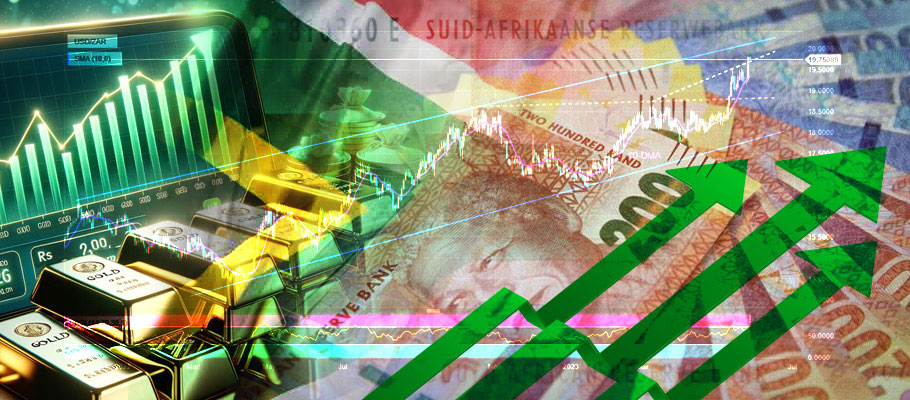
Published: May 1st, 2024
A new analysis by investment bank Société Générale shows the correlation between the South African Rand (ZAR) and gold prices has reached a seven-month high.
Rand has been one of the top-performing emerging market currencies for the year to date, a performance that has taken many forex traders and analysts by surprise given the political uncertainty in the country.
In a recent note to investors, Société Générale analysts said ZAR's strong relative outperformance should raise eyebrows, especially when the unsupportive global backdrop is factored in.
Rising global interest rates and fading hopes for a cut this year by the US Federal Reserve should have combined to dull enthusiasm. And yet “the ongoing gold rally explains the Rand’s resilience, at least in part, amid the broadly stronger dollar environment".
The steady rise in gold’s price recently touched a record high of USD 2,429, adding to ZAR’s appeal, says the bank, since the yellow metal is one of South Africa’s top exports. The 120-day correlation between gold and the Rand reached a seven-month high of 0.465 this week.
There are other contributing factors. The fiat has also benefitted from Pretoria’s decision to allocate eight billion USD from the South African Reserve Bank’s foreign currency account to government debt payments over the next three years.
But ZAR outperformance (against other emerging market currencies) is still surprising in an election year where conflicting polls make it difficult to predict the outcome. With the general election scheduled for 29th May, the most recent opinion poll has the ruling ANC party set to lose its majority. Société Générale says there is also speculation that voter support could sink to historic lows thanks to crushing poverty, unemployment and frequent power blackouts.
In June 2022, ZAR was buoyant off the back of traditional economic indicators, which painted a brighter picture for South Africa’s economy than markets had expected, strengthening a favourable policy outlook for the Rand by the South African Reserve Bank (SARB).
At the start of month, Rand had notched up noteworthy gains over many of its G20 currency group peers, echoing the positive performance seen across late May 2022 and early June. ZAR topped the G20 league table for the 2022 year-to-date before receiving another boost from better-than-expected economic growth figures that seemed to take forex traders by surprise.
In a note to investors, currency analysts at Investec wrote that 'the upbeat GDP figures for the first quarter of 2022 have piled on more pressure for higher South African interest rates. A 50 basis-points hike at the SARB’s July policy meeting appears more likely now than a 25 basis-points rise.
‘In our view the central bank’s Monetary Policy Committee (MPC) is likely to push up the repo rate by 100 basis points in total for the second half of the year across its July and September meetings. ZAR would find itself under marked pressure if the SARB allows a differential to narrow between South African and American interest rates.”
Figures from Statistics South Africa showed that the continent’s southernmost national economy expanded at an annualized rate of three per cent in the first quarter of the year. That confounded economic consensus that had been looking for a growth rate of 1.7 per cent, which would have been essentially unchanged from Q4 2021.
The numbers followed other figures that indicated falling unemployment in the labour market in the same period. It was the first time South African joblessness numbers had fallen since the start of the COVID-19 pandemic.
Markets were watching for mining production and manufacturing figures that due out later in the month, which delivered a sneek-peek at the pace of growth key domestic industries have posted for the opening months of Q2 2022.
The Emerging Markets Forex unit at Commerzbank wrote in a market analysis that 'improving market sentiment and waning strength in the Greenback mean ZAR has recovered significantly from its mid-May doldrums. These latest GDP figures are providing added support.’
Commerzbank analysts warn however that despite positive first quarter data, the flooding seen in Kwa-Zulu Natal province in May and the recent bout of load-shedding from national power utility Eskom might be enough to cool economic growth in Q2.
Those sentiments were echoed by Investec analysts, who wrote that the Bureau for Economic Research’s (BER) Q2 business confidence index might deliver a more accurate and complete picture of about the South African economy’s real performance during the three months to the end of June.
Investec analysts also said that ZAR had benefited from rising global commodity prices. When blended with a stable domestic economy, the two factors have combined to give offshore investors healthy returns. They do warn that higher oil prices will keep the Rand under pressure, particularly if the next round of economic data show slowing GDP growth in the second quarter.
‘ZAR has benefitted from a large trade and current account surplus over the past two years. It’s possible that could shrink or even reverse in the coming quarters.’
The bank said Rand had appreciated in value by 6.2 per cent for the year-to-date against the currencies of its largest trading partners. Those gains also caught some investors off guard since ZAR is considered a 'high beta' currency that tends to depreciate when geopolitical anxiety (for example, the Ukraine crisis) rises.
Investors have certainly been unsettled by Russia's ongoing military action, however Rand has attracted support due to rising demand for alternative sources of raw materials, boosting its commodity exports.
Investec wrote that a surge in metal prices has been a key driver for Rand across Q1, as worries about sanctions on Russian commodity exports push prices up amid fears about lack of supply.
Other antipodean commodity currencies like the Australian (AUD) and New Zealand (NZD) dollars have also benefitted. Like Rand, they tend to depreciate when global investors get market jitters. All are attracting new levels of support thanks to the extended bout of geopolitical and supply chain disruption.